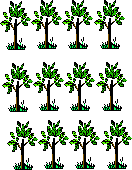Solve multiplication problems by using repeated addition.
Change the order of the factors to make a multiplication problem easier.
Number Framework Stages 5 and 6.
- Animal strips
- Multiplication or not (Material Master 6-2)
Using Materials
While students are not looking lay down five three-animal cards in an array (rows and columns). Ask the students to work out how many animals there are in total in any way they can. Record the strategies that they use with symbols, for example:
3 + 3 + 3 + 3 + 3, 5 + 5 + 5, 10 + 5, 5 × 3, 3 × 5
Discuss the meaning of the symbols in each expression.
Ask, What should be done to turn the animal array into 7 × 3? (add two three-animal
cards)
Ask, What would the total number of animals be for seven rows of three? Get students to explain how they found their answers.
Provide other arrays for students to see. Record each array as an operation expression, as students suggest them. Suitable arrays might be:
.gif)
Lay down multiplication cards, eg. 6 × 5. Invite students to form the array and work
out the total number of animals involved.
Using Imaging
Form arrays with the animal cards but turn the cards upside down.
Turn over and back one or two cards in the array to allow students to recognise one of the factors.
Ask them what multiplication expression would give the total number of animals.

Allow the student to work out the total number of animals by imaging. Encourage
part-whole methods such as 4 + 4 = 8, 8 + 8 = 16.
Place more animal strips of the same size in the array and ask students to use the
previous operation to work out the next. Similarly take strips away from the array.
Record the operations using multiplication statements:
4 × 4 = 16, so 5 × 4 = 20, so 7 × 4 = 28, etc.
Suitable arrays might be:
3 × 6 = ? so 4 × 6 = ? 4 × 5 = ? so 6 × 5 = ?
7 × 2 = ? so 6 × 2 = ? 6 × 3 = ? so 5 × 3 = ?
Using Number Properties
Provide the students with related multiplication problems. Discuss the meaning of
each problem. For example 10 × 3 = ∞ so 9 × 3 = ∞ , as, “ten sets of three, ”and
“nine sets of three.”
Look for students to use either knowledge of the fact or part-whole methods to solve
each problem and to derive one fact from the other. For example, 10 × 3 = 30 so 9 × 3 = 27, three less.
Suitable problems are:
2 × 8 = ? so 3 × 8 = ? 2 × 7 = ? so 3 × 7 = ?
5 × 4 = ? so 6 × 4 = ? 5 × 6 = ? so 6 × 6 = ?
10 × 4 = ? so 9 × 4 = ? 10 × 7 = ? so 9 × 7 = ?
Independent Work
Use the animal cards (Materials Master 5-2) and the multiplication cards (Material
Master 6-2) to play the game of “Multiplication or Out”.